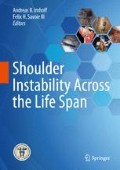Abstract
Articular cartilage shows very limited self-healing capacity, which is why damages to this tissue can lead to significant impairment of the joint function. Despite scientific progress regarding diagnosis and treatment of cartilage defects in recent years, they still represent a challenge to orthopedic clinicians, which is even more applicable for the shoulder in comparison to other joints. Since lesions of the chondral layer are a risk factor for the development of osteoarthritis, early detection and adequate therapy are crucial, especially in young and active patients, to avoid rapid deterioration of the joint function and the need for early arthroplasty.
Access this chapter
Tax calculation will be finalised at checkout
Purchases are for personal use only
References
Anderl W, Kriegleder B, Neumaier M, Laky B, Heuberer P. Arthroscopic partial shoulder resurfacing. Knee Surg Sports Traumatol Arthrosc. 2015;23(5):1563–70. doi:10.1007/s00167-00014-02981-x. Epub 02014 Apr 00122.
Buchmann S, Salzmann GM, Glanzmann MC, Wortler K, Vogt S, Imhoff AB. Early clinical and structural results after autologous chondrocyte transplantation at the glenohumeral joint. J Shoulder Elbow Surg. 2012;21(9):1213–21. doi:10.1016/j.jse.2011.1207.1030. Epub 2011 Nov 1212.
Cameron ML, Kocher MS, Briggs KK, Horan MP, Hawkins RJ. The prevalence of glenohumeral osteoarthrosis in unstable shoulders. Am J Sports Med. 2003;31(1):53–5.
Elser F, Braun S, Dewing CB, Millett PJ. Glenohumeral joint preservation: current options for managing articular cartilage lesions in young, active patients. Arthroscopy. 2010;26(5):685–96. doi:10.1016/j.arthro.2009.1010.1017. Epub 2010 Apr 1018.
Frank RM, Van Thiel GS, Slabaugh MA, Romeo AA, Cole BJ, Verma NN. Clinical outcomes after microfracture of the glenohumeral joint. Am J Sports Med. 2010;38(4):772–81. doi:10.1177/0363546509350304. Epub 0363546509352010 Jan 0363546509350321.
Hodler J, Loredo RA, Longo C, Trudell D, Yu JS, Resnick D. Assessment of articular cartilage thickness of the humeral head: MR-anatomic correlation in cadavers. AJR Am J Roentgenol. 1995;165(3):615–20.
Kircher J, Patzer T, Magosch P, Lichtenberg S, Habermeyer P. Osteochondral autologous transplantation for the treatment of full-thickness cartilage defects of the shoulder: results at nine years. J Bone Joint Surg Br. 2009;91(4):499–503. doi:10.1302/0301-1620X.1391B1304.21838.
Krych AJ, Sousa PL, King AH, Morgan JA, May JH, Dahm DL. The effect of cartilage injury after arthroscopic stabilization for shoulder instability. Orthopedics. 2015;38(11):e965–9. doi:10.3928/01477447-20151020-01477403.
Minas T, Gomoll AH, Rosenberger R, Royce RO, Bryant T. Increased failure rate of autologous chondrocyte implantation after previous treatment with marrow stimulation techniques. Am J Sports Med. 2009;37(5):902–8. doi:10.1177/0363546508330137. Epub 0363546508332009 Mar 0363546508330134.
Ruckstuhl H, de Bruin ED, Stussi E, Vanwanseele B (2008) Post-traumatic glenohumeral cartilage lesions: a systematic review. BMC Musculoskelet Disord 9:107. doi:10.1186/1471-2474-1189-1107.
Saxena V, D’Aquilla K, Marcoon S, Krishnamoorthy G, Gordon JA, Carey JL, Borthakur A, Kneeland JB, Kelly JDt, Reddy R, Sennett BJ. T1rho magnetic resonance imaging to assess cartilage damage after primary shoulder dislocation. Am J Sports Med. 2016:0363546516655338.
Scheibel M, Bartl C, Magosch P, Lichtenberg S, Habermeyer P. Osteochondral autologous transplantation for the treatment of full-thickness articular cartilage defects of the shoulder. J Bone Joint Surg Br. 2004;86(7):991–7.
Steadman JR, Rodkey WG, Briggs KK. Microfracture to treat full-thickness chondral defects: surgical technique, rehabilitation, and outcomes. J Knee Surg. 2002;15(3):170–6.
Zumstein V, Kraljevic M, Conzen A, Hoechel S, Muller-Gerbl M. Thickness distribution of the glenohumeral joint cartilage: a quantitative study using computed tomography. Surg Radiol Anat. 2014;36(4):327–31. doi:10.1007/s00276-00013-01221-00272. Epub 02013 Oct 00231.
Author information
Authors and Affiliations
Corresponding author
Editor information
Editors and Affiliations
Rights and permissions
Copyright information
© 2017 ISAKOS
About this chapter
Cite this chapter
Mehl, J., Beitzel, K. (2017). Cartilage Defects. In: Imhoff, A., Savoie III, F. (eds) Shoulder Instability Across the Life Span. Springer, Berlin, Heidelberg. https://doi.org/10.1007/978-3-662-54077-0_26
Download citation
DOI: https://doi.org/10.1007/978-3-662-54077-0_26
Published:
Publisher Name: Springer, Berlin, Heidelberg
Print ISBN: 978-3-662-54076-3
Online ISBN: 978-3-662-54077-0
eBook Packages: MedicineMedicine (R0)

